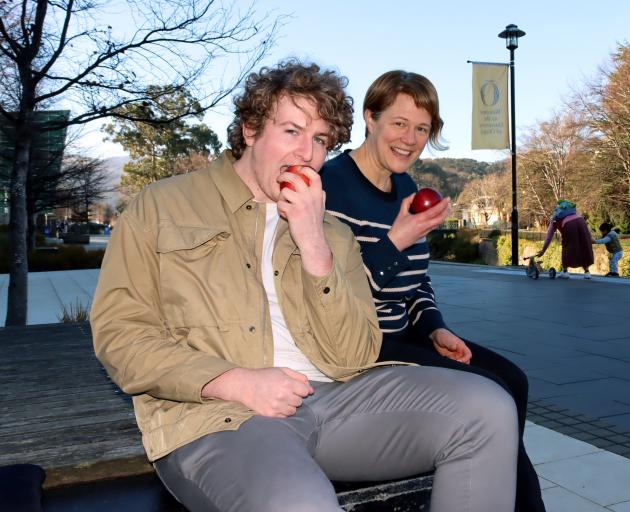Science
Student Analyzes 300 Apple Varieties at New Zealand Heritage Orchard

Aaron Hewson, a master of science student in plant biotechnology, is conducting research on over 300 apple varieties at the Jim Dunckley Heritage Orchard in New Zealand. Established 25 years ago by the Coastal Otago Branch of the New Zealand Tree Crops Association, this orchard is recognized for housing one of the most diverse collections of apple cultivars in the country.
Hewson’s work aims to support the preservation and propagation of these heritage cultivars, ensuring their identification through genetic analysis. The orchard’s collection was initiated by Jim Dunckley in the 1990s, with apples gathered from various locations in Otago and Southland. Most of the varieties originated from Clyde, where an old Plant & Food Research orchard was located. Hewson described the collection as a “real kind of hodgepodge mix,” with some trees named after local landmarks by farmers, which do not always align with their genetic origins.
During his research, Hewson encountered instances of misnamed varieties. For instance, he found that a cultivar labeled as Granny Smith, commonly found in supermarkets, and another called Lord Lambourne exhibited identical genetic markers. “These two cultivars should be really different, but the samples were saying they were genetically the same. So one of those names has to be wrong,” Hewson explained.
To analyze the genetic makeup of these varieties, samples were collected by students and staff from the Plant Biochemistry Lab, labeled, and freeze-dried. These samples were then sent to a laboratory in France for analysis, facilitated by Plant & Food Research, now part of the Bioeconomy Science Institute. Hewson expressed gratitude for the support and expertise of his co-supervisor, Dr. Elena Lopez-Girona, during this process.
The genetic analysis employs a technique known as SNP chip genotyping, which examines approximately 50,000 specific DNA hotspots in apple leaves. This method produces a genetic fingerprint that helps determine whether two trees are of the same variety or different.
The significance of conserving these heritage varieties extends beyond mere identification. Due to stringent biosecurity regulations, importing new apple genetics is challenging, making local collections vital for future breeding efforts, particularly in enhancing disease resistance. Hewson emphasized the narrow genetic base of commercial apple varieties globally, stating, “If we talk about the entire amount of apples across the world, there is something on the order of 10,000 different varieties. But all of our commercial varieties, no matter how many there are, they all come from six apples, so it is really, really narrow.”
Hewson’s other co-supervisor, Associate Professor Lynnette Brownfield from the University of Otago, highlighted the value of identifying the genetic diversity within the orchard. This knowledge could assist breeders in discovering fresh genetic material, including traits related to disease resistance, which could expand future breeding options.
The Coastal Otago Branch of the New Zealand Tree Crops Association, which owns the orchard, will determine how to utilize the genetic information gathered from this research. The overarching goal is to assign unique identifiers to all trees in the collection, ensuring comprehensive knowledge of the varieties present. This will facilitate collaboration with apple breeders, ranging from backyard growers to large organizations like Plant & Food Research, and assist in providing germplasm as needed.
-

 World4 months ago
World4 months agoTest Your Knowledge: Take the Herald’s Afternoon Quiz Today
-

 Sports4 months ago
Sports4 months agoPM Faces Backlash from Fans During Netball Trophy Ceremony
-

 Lifestyle4 months ago
Lifestyle4 months agoDunedin Designers Win Top Award at Hokonui Fashion Event
-

 Entertainment4 months ago
Entertainment4 months agoExperience the Excitement of ‘Chief of War’ in Oʻahu
-

 Sports4 months ago
Sports4 months agoLiam Lawson Launches New Era for Racing Bulls with Strong Start
-

 World5 months ago
World5 months agoCoalition Forms to Preserve Māori Wards in Hawke’s Bay
-

 Health4 months ago
Health4 months agoWalking Faster Offers Major Health Benefits for Older Adults
-

 Lifestyle4 months ago
Lifestyle4 months agoDisney Fan Reveals Dress Code Tips for Park Visitors
-

 Politics4 months ago
Politics4 months agoScots Rally with Humor and Music to Protest Trump’s Visit
-

 Top Stories5 months ago
Top Stories5 months agoUK and India Finalize Trade Deal to Boost Economic Ties
-

 Health2 months ago
Health2 months agoRadio Host Jay-Jay Feeney’s Partner Secures Visa to Stay in NZ
-

 World5 months ago
World5 months agoHuntly Begins Water Pipe Flushing to Resolve Brown Water Issue









